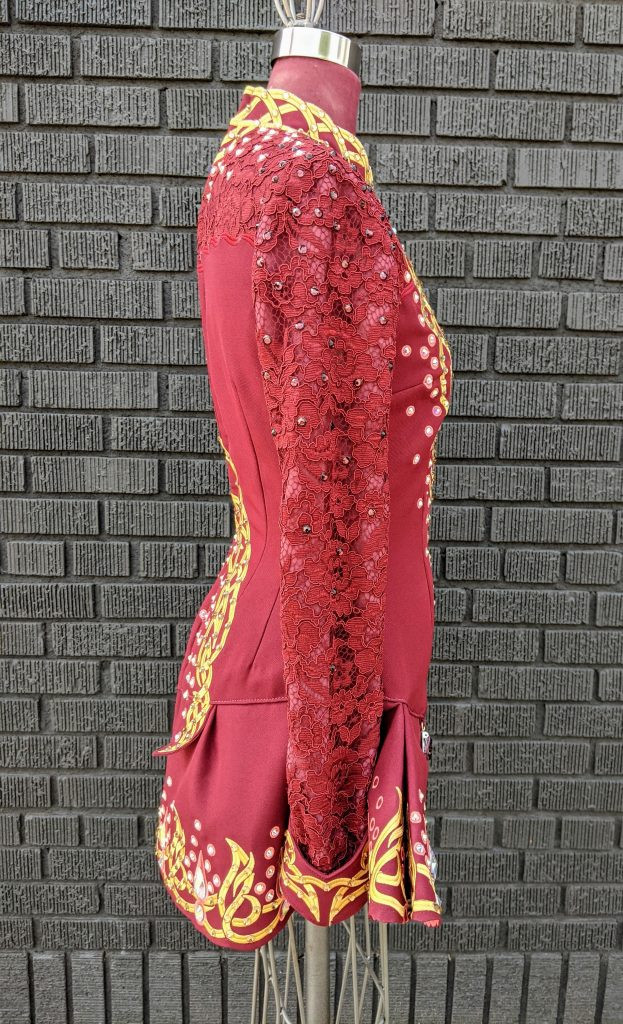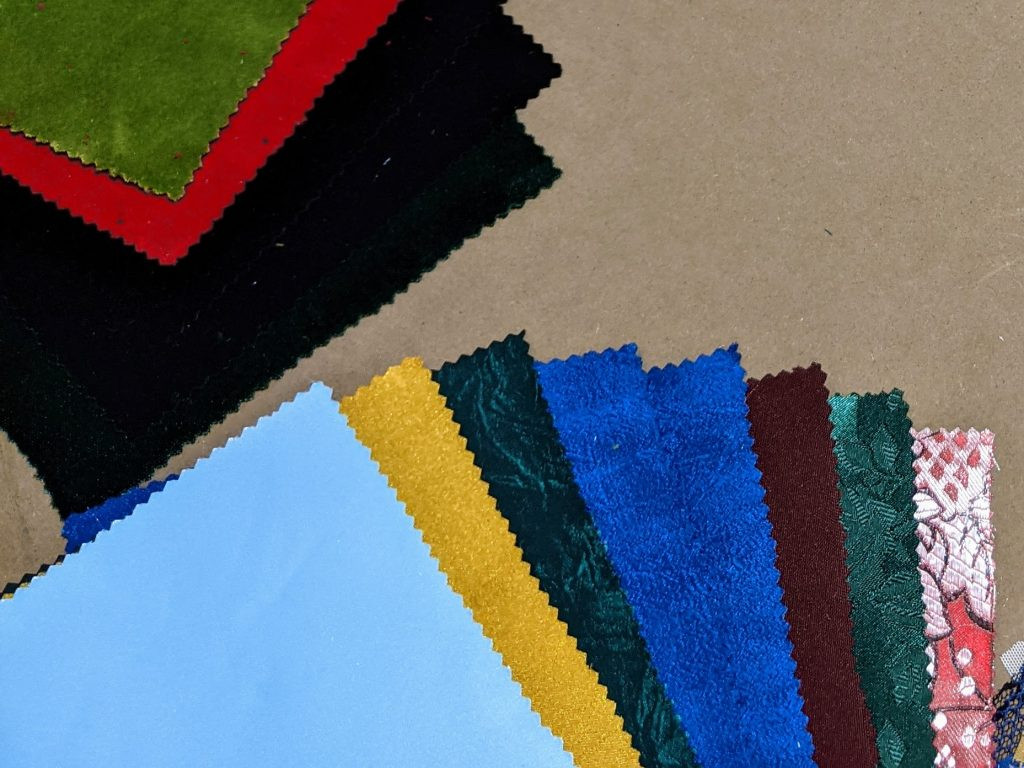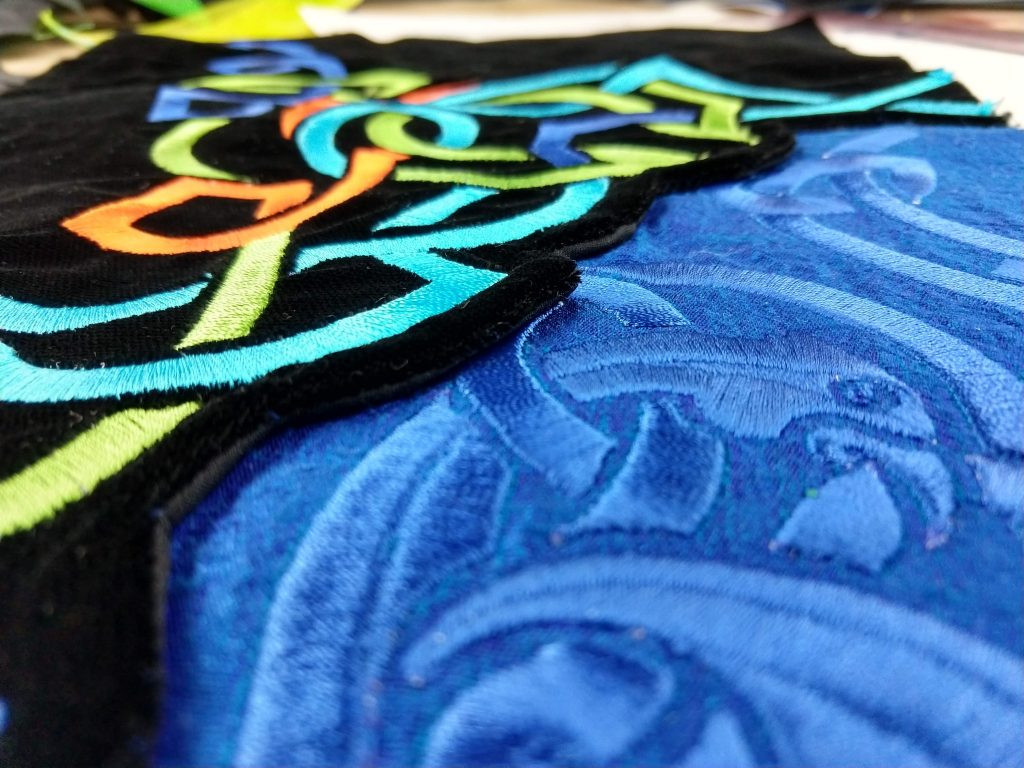Irish dance dresses are more than just costumes; they are symbols of tradition, artistry, and personal expression. At ten-dance.com, we understand the allure and the challenge of creating these intricate garments. We’ll guide you through the process, offering insights and tips to help you craft a dress that not only meets competition standards but also reflects your unique style. Whether you’re looking to understand the nuances of skirt construction, fabric selection, or embellishment techniques, we’re here to provide the knowledge and resources you need. Let’s explore the world of Irish dance dressmaking together!
1. What Exactly Is An Irish Dance Solo Dress?
An Irish dance solo dress is a specialized costume worn by dancers, typically female-identifying, in individual competitions, designed to showcase their personal style while adhering to specific competition standards. Unlike school costumes, which represent a dance school and may influence adjudicators, solo dresses allow dancers to express their individuality.
1.1. Evolution of Solo Dresses
Solo dresses have evolved significantly over the decades. According to research from the An Coimisiún Le Rincí Gaelacha (CLRG), the governing body for Irish dance, the modern solo dress emphasizes individuality and personal expression. Early dresses, like those from the 1960s, were simpler in design and construction. Dresses from the 2000s began to incorporate more elaborate embellishments and bolder designs, with the 2020s seeing the rise of highly customized dresses that reflect the dancer’s unique style.
1.2. Key Features of a Modern Solo Dress
- Long Bodice: Extends down to the hips.
- Dropped V-Shaped Waist: Creates a flattering silhouette.
- Slim Sleeves: Fitted to the arms for a sleek look.
- Center-Back Zipper: Ensures a snug fit.
- Short Skirt: Flat in the front with a distinctive outward flare at the sides.
- Optional Cape: Can be attached with Velcro or integrated into the design.
2. What Are The Essential Garment Features of An Irish Dance Dress?
The essential garment features of an Irish dance dress include a structured skirt, a fitted bodice, and various embellishments that enhance the overall aesthetic. These features combine to create a visually stunning and functional costume that allows dancers to perform at their best.
2.1. The Skirt: A Closer Look
The skirt is arguably the most distinctive aspect of an Irish dance dress. Its unique construction sets it apart from typical apparel sewing.
- Stiff Frame: Made from heavy interfacing and boning.
- Unique Shape: Flat across the front and flares out sharply at the sides.
- Large Pleats: Positioned on each side of the skirt, slightly forward of the side seam, maintaining a flat front.
- Top-Stitching: Secures the bodice to the skirt due to the angled seam.
 Irish dance dress skirt frame
Irish dance dress skirt frame
2.2. Bodice Construction
The bodice is meticulously constructed to provide both structure and aesthetic appeal.
- Multiple Layers: Typically consists of a base layer for support and an outer “fashion fabric.”
- Basted Together: Each piece of the bodice is made from two layers basted together, treated as one.
- Seam Accessibility: Lining each piece individually allows for easy alterations, accommodating growth or changes in ownership.
2.3. Cape Variations
Capes add a dynamic element to the dress, with styles ranging from:
- Traditional Swaths: Long pieces of fabric pinned to the back.
- Modern Patches: Small pieces attached with Velcro.
- Cape-Less Designs: Many contemporary dresses omit the cape altogether for a streamlined look.
3. What Types of Fabrics and Stiffeners Are Best For Irish Dance Dresses?
Selecting the right fabrics and stiffeners is crucial for creating an Irish dance dress that not only looks stunning but also performs well. The choice of materials can significantly impact the dress’s structure, movement, and overall durability.
3.1. Bodice Fabrics
- Fashion Fabrics: Options include satin, velvet, silk, gabardine, and power mesh.
- Base Layer: Provides structure to thinner fashion fabrics. Lightweight twill is recommended for fabrics like satin or silk, while thin cotton broadcloth or woven fusible interfacing like Pellon ShapeFlex works well for bulkier fabrics such as velvet.
- Lining Fabrics: Adds comfort and a smooth finish to the interior of the bodice.
3.2. Skirt Fabrics
- Outer Fashion Fabric: Similar to bodice fabrics, options include satin, velvet, and silk.
- Base Layer: A medium-to-heavy-weight sew-in interfacing is recommended for adding structure.
- Lining: Ensures comfort and prevents the interfacing from irritating the dancer’s skin.
3.3. Stiffeners
- Heavy Interfacing (“Dress Stiffener”): Provides the skirt’s frame, creating its unique shape.
- Boning: Adds additional support to maintain the skirt’s structure.
 Irish dance dress fabric
Irish dance dress fabric
3.4. Where to Source Fabrics and Stiffeners
High-quality fabrics and stiffeners can be sourced from:
- Specialty Fabric Stores: These stores often carry a wide range of materials specifically suited for costume design.
- Online Retailers: Websites like Fabric.com and Mood Fabrics offer a vast selection of fabrics and ship directly to your door.
- Theatrical Supply Stores: These stores specialize in materials for theatrical costumes, including heavy interfacings and boning.
4. How Can I Master Embroidery and Embellishment Techniques for Irish Dance Dresses?
Mastering embroidery and embellishment techniques is essential for creating a standout Irish dance dress. These details add visual appeal and allow for personal expression.
4.1. Embroidery Techniques
- Machine Embroidery: Utilize an embroidery machine to create intricate designs. You can design your own artwork or purchase digitized designs.
- Free-Hand Satin Stitch: Use the zig-zag function on your sewing machine to create satin-stitch designs manually.
4.2. Embellishment Options
- Pre-Made Appliques: Use embroidered or lace appliques for a quick and easy embellishment.
- Lace Fabric: Create beautiful designs by cutting and arranging pieces of lace fabric.
- Sequin Trim: Add sparkle with sequin trim.
- Crystals: Strategically place crystals to catch the light and add glamour.
4.3. Timing is Key
Embroidery should be completed after the fabric pieces are cut but before the garment is constructed. This ensures that the embellishments are properly integrated into the dress.
4.4. Design Inspiration
- Irish Dance Magazines: Magazines like “Irish Dancing & Culture” often showcase stunning dress designs.
- Online Galleries: Websites like Pinterest and Instagram feature numerous examples of beautifully embellished Irish dance dresses.
- Dance Competitions: Attending competitions provides an opportunity to see a variety of dress designs in person.
5. What Steps Are Involved In The Irish Dance Dress Sewing Process?
The Irish dance dress sewing process involves several key steps, from initial design to final embellishments. Each step requires careful attention to detail to ensure a professional and visually stunning result.
5.1. Design and Pattern Selection
- Sketching: Start by sketching out your design ideas. Consider the overall look you want to achieve, including the color scheme, embellishments, and style of the skirt and bodice.
- Pattern: Many experienced sewers prefer to create their own patterns, while others buy patterns.
- Measurement: Accurate measurement is critical to ensure a well-fitted dress.
5.2. Fabric Preparation
- Cutting: Cut out all the fabric pieces according to your pattern.
- Layering: Baste the base layer to the outer fashion fabric for each piece of the bodice and skirt.
5.3. Bodice Construction
- Sewing: Sew the bodice pieces together, ensuring a snug and comfortable fit.
- Lining: Add the lining to the bodice, which helps to create a smooth interior finish.
5.4. Skirt Construction
- Frame Assembly: Construct the skirt frame using heavy interfacing and boning.
- Fabric Attachment: Attach the outer fabric and lining to the skirt frame.
- Pleating: Create the distinctive pleats on each side of the skirt.
5.5. Joining Bodice and Skirt
- Top-Stitching: Top-stitch the bodice to the skirt, ensuring a secure and seamless join.
5.6. Embellishment
- Embroidery: Add embroidery to the bodice and skirt before final assembly.
- Appliques and Crystals: Attach appliques, crystals, and other embellishments to enhance the dress’s visual appeal.
5.7. Final Touches
- Zipper Installation: Install the center-back zipper.
- Hemming: Hem the skirt to the desired length.
- Cape Attachment: If using a cape, attach it securely to the back of the dress.
6. How Can Ten-Dance.Com Help You Create Your Irish Dance Dress?
At ten-dance.com, we are dedicated to providing you with the resources, information, and support you need to create a stunning Irish dance dress. Our platform offers a variety of services to assist you at every stage of the dressmaking process.
6.1. Expert Articles and Tutorials
Our website features a wealth of articles and tutorials on Irish dance dressmaking. From detailed guides on fabric selection to step-by-step instructions on skirt construction, our content is designed to help you master the art of dressmaking.
6.2. Community Forum
Join our community forum to connect with other Irish dance enthusiasts. Share your experiences, ask questions, and get advice from experienced dressmakers and dancers.
6.3. Design Templates
Download our free design templates to sketch out your ideas and experiment with different looks. These templates are perfect for visualizing your dress design before you start sewing.
6.4. Recommended Resources
We also recommend exploring other resources, such as:
- Irish Dance Teachers: Many dance teachers have experience with dressmaking and can provide valuable advice.
- Local Seamstresses: Consider hiring a professional seamstress who specializes in Irish dance dresses.
- Online Communities: Websites like the Irish Dance Costumes Forum offer a wealth of information and support.
7. Where Can You Find Inspiration for Your Irish Dance Dress Design?
Finding inspiration for your Irish dance dress design can come from various sources, blending traditional elements with contemporary flair. Here’s how to ignite your creativity and craft a unique dress:
7.1. Cultural and Historical Research
- Traditional Motifs: Explore Celtic knots, shamrocks, and other traditional Irish symbols that can be incorporated into your design.
- Historical Dresses: Research the evolution of Irish dance dresses through the decades to understand how styles have changed and adapted.
7.2. Modern Fashion Trends
- Color Palettes: Stay updated on current fashion color trends and consider how they can be integrated into your dress design.
- Embellishment Techniques: Look to high fashion for innovative embellishment techniques, such as unique beadwork or unconventional fabric combinations.
7.3. Nature and Art
- Nature-Inspired Designs: Draw inspiration from natural elements like flowers, landscapes, and animals to create organic and flowing designs.
- Artistic Interpretations: Translate abstract art concepts into fabric, using color and texture to create a visually striking dress.
7.4. Personal Interests
- Reflect Your Personality: Incorporate elements that reflect your personal interests and passions. This could include favorite colors, symbols, or themes.
- Collaborate with Your Dancer: If you’re making a dress for someone else, involve them in the design process to ensure the dress reflects their personality and style.
8. What Are The Current Trends in Irish Dance Dress Designs?
Staying updated on current trends in Irish dance dress designs can help you create a modern and competitive look. Here are some of the prevailing trends:
8.1. Bold Color Combinations
- Unexpected Palettes: Experiment with color combinations that are both vibrant and unexpected. Pair jewel tones with pastels, or mix warm and cool colors for a dynamic effect.
- Ombré Effects: Create a gradient effect by blending different shades of the same color. This can add depth and dimension to the dress.
8.2. Intricate Embroidery and Appliqués
- 3D Embroidery: Use raised embroidery techniques to add texture and dimension to your designs.
- Custom Appliqués: Create unique appliqués from lace, leather, or other materials. These can be hand-sewn or machine-applied to the dress.
8.3. Streamlined Silhouettes
- Asymmetrical Designs: Experiment with asymmetrical hemlines, necklines, or bodice designs.
- Minimalist Embellishments: Focus on a few key embellishments rather than overwhelming the dress with detail.
8.4. Sustainable Materials
- Eco-Friendly Fabrics: Choose organic cotton, bamboo, or recycled polyester for your dress.
- Upcycled Embellishments: Incorporate vintage lace, buttons, or beads into your designs.
 Irish dance dress embellishment
Irish dance dress embellishment
9. How To Properly Care For and Maintain Your Irish Dance Dress?
Proper care and maintenance are essential for preserving the beauty and longevity of your Irish dance dress. Follow these tips to keep your dress in top condition:
9.1. Cleaning
- Spot Cleaning: Use a gentle stain remover to spot clean any dirt or stains. Avoid harsh chemicals that can damage the fabric.
- Professional Cleaning: For thorough cleaning, take your dress to a professional cleaner specializing in delicate fabrics.
9.2. Storage
- Hanging: Hang your dress on a padded hanger to prevent wrinkles and maintain its shape.
- Garment Bag: Store your dress in a breathable garment bag to protect it from dust and sunlight.
9.3. Repair
- Prompt Repairs: Address any tears, loose seams, or missing embellishments as soon as possible to prevent further damage.
- Professional Alterations: For significant repairs or alterations, consult a professional seamstress who specializes in Irish dance dresses.
9.4. Travel
- Protective Case: When traveling with your dress, use a hard-sided garment case to protect it from damage.
- Packing: Pack your dress carefully, using acid-free tissue paper to cushion and prevent wrinkles.
10. Where Can You Find More Resources and Support for Irish Dance Dressmaking?
Finding the right resources and support can significantly enhance your Irish dance dressmaking journey. Here are some valuable places to turn:
10.1. Dance Schools and Instructors
- Expert Advice: Dance teachers often have extensive knowledge about dress design and can offer valuable advice and recommendations.
- Networking: Connect with other dancers and parents who may have experience with dressmaking.
10.2. Online Forums and Communities
- Irish Dance Costumes Forum: This online forum is a hub for dressmakers and dancers to share tips, ask questions, and showcase their creations.
- Social Media Groups: Join Facebook groups or other social media communities dedicated to Irish dance costumes.
10.3. Fabric Stores and Suppliers
- Knowledgeable Staff: Fabric store employees can offer advice on fabric selection, interfacing, and embellishments.
- Workshops and Classes: Many fabric stores offer workshops and classes on sewing and embellishment techniques.
10.4. Ten-Dance.Com Community
- Join the Community: Sign up to ten-dance.com to access all our information and connect to other dancers
10.5. Address and Contact Information
For further assistance, you can visit us at:
Address: 60 Lincoln Center Plaza, New York, NY 10023, United States
Phone: +1 (212) 769-7000
Website: ten-dance.com
Crafting an Irish dance dress is a rewarding journey that combines creativity, skill, and attention to detail. With the right resources and guidance, you can create a dress that reflects your unique style and helps you shine on the dance floor. Join us at ten-dance.com to explore our comprehensive resources, connect with a vibrant community, and take your Irish dance dressmaking skills to the next level. Start your dressmaking adventure today and let your creativity soar!
FAQ: Your Questions About Making Irish Dance Dresses Answered
1. What is the best fabric to use for an Irish dance dress?
The best fabric for an Irish dance dress combines durability, aesthetic appeal, and comfort. Popular choices include velvet, satin, and gabardine for the outer layer, providing a rich look and feel. For the base layer, lightweight twill or cotton broadcloth offers structure and support. These fabrics allow for intricate embellishments while ensuring the dress moves gracefully with the dancer.
2. How much fabric do I need to make an Irish dance dress?
The amount of fabric needed varies depending on the dress size, design complexity, and whether you include a cape. Typically, you’ll need about 4-6 yards of fashion fabric for the outer layer, 3-5 yards of base layer fabric, and 2-3 yards of lining. Always buy extra to account for mistakes and design adjustments.
3. What type of interfacing should I use for the skirt?
For the skirt, a heavy sew-in interfacing is ideal as it provides the necessary stiffness and support to maintain the skirt’s shape. Options like buckram or heavy canvas can be used for the frame, ensuring the skirt flares out appropriately.
4. Can I make an Irish dance dress without an embroidery machine?
Yes, you can definitely make an Irish dance dress without an embroidery machine. Hand embroidery techniques like satin stitch can create beautiful designs, or you can use pre-made embroidered appliques and sequin trims to add intricate details.
5. How do I create the stiff skirt shape?
The stiff skirt shape is achieved by constructing a frame using heavy interfacing and boning. This frame is then sandwiched between the outer fabric and lining, creating the signature flare. Precise cutting and careful assembly are crucial for achieving the correct shape.
6. Where can I find patterns for Irish dance dresses?
Patterns for Irish dance dresses can be found at specialty pattern shops, online retailers like Etsy, and through independent designers who specialize in dance costumes. Look for patterns that match your skill level and design preferences.
7. How do I properly store an Irish dance dress to prevent damage?
Store your Irish dance dress in a breathable garment bag on a padded hanger to maintain its shape and protect it from dust and sunlight. Avoid storing it in plastic bags, which can trap moisture and cause mildew.
8. How much does it cost to make an Irish dance dress?
The cost of making an Irish dance dress can vary widely depending on the materials used and the complexity of the design. On average, you can expect to spend anywhere from $300 to $1000 on materials, including fabric, interfacing, embellishments, and notions.
9. What are the key differences between a beginner and advanced Irish dance dress?
Beginner dresses are typically simpler in design, with less intricate embellishments and basic fabrics. Advanced dresses often feature more elaborate embroidery, higher-quality fabrics, and more complex construction techniques to create a standout look.
10. How can I ensure my Irish dance dress meets competition standards?
Ensure your Irish dance dress meets competition standards by consulting the rules and guidelines set by organizations like An Coimisiún Le Rincí Gaelacha (CLRG). Pay attention to skirt length, sleeve style, and allowed embellishments to avoid deductions during competition.
